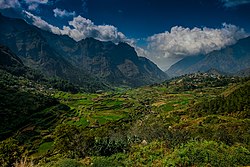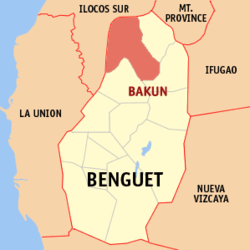Bakun, Benguet Last updated January 01, 2026 Municipality in Benguet, Philippines
Municipality in Cordillera Administrative Region, Philippines
Bakun , officially the Municipality of Bakun , (Ilocano : Ili ti Bakun Tagalog : Bayan ng Bakun municipality in the province of Benguet , Philippines . According to the 2024 census, it has a population of 15,399 people. [ 5]
History During the Spanish Period , Bakun was a rancheria of the Commandancia Politico-Militar de Amburayan barangay of Bakun) was a rancheria of the Commandancia Politico Militar de Tiagan, Distrito de Benguet . [ 6]
When the United States took control of the Philippines , the American Congress issued Act No. 48 in November 1900, placing Bakun under the province of Amburayan, and Ampusongan under the province of Benguet. [ 7] On August 13, 1908, Benguet became a subprovince of the newly established Mountain Province with the enactment of Act No. 1876 , and the municipal districts of Bakun and Ampusongan became part of the subprovince. [ 8]
In 1917, the Bureau of Non-Christian Tribes recommended that the western border of the Mountain Province be pushed eastward, such that the entire subprovince of Amburayan and large slices of Lepanto and Benguet would be made part of Ilocos Sur and La Union . In early 1937, Ampusongan was merged with Bakun, the latter carrying the name of the township while the former became a barangay. [ 6] The issuance of Republic Act No. 4695 in 1966 included Bakun as a regular municipality in the newly created province of Benguet. [ 9]
Geography The Municipality of Bakun is located at 16°47′33″N 120°39′41″E / 16.7925°N 120.6614°E / 16.7925; 120.6614 Mankayan on the east, Buguias on the southeast, Kibungan on the south, Sugpon on the south-west, Alilem on the north-west, and Cervantes on the north.
According to the Philippine Statistics Authority , the municipality has a land area of 286.91 square kilometres (110.78 sq mi) [ 10] constituting 10.36% of the 2,769.08-square-kilometre- (1,069.15 sq mi) total area of Benguet.
Bakun is situated 78.55 kilometres (48.81 mi) from the provincial capital La Trinidad , and 334.33 kilometres (207.74 mi) from the country's capital city of Manila .
Barangays Bakun is politically subdivided into 7 barangays . [ 11] Each barangay consists of puroks and some have sitios .
PSGC Barangay Population ±% p.a. 2024 [ 12] 2010 [ 13] 141103001 Ampusongan 16.4% 2,532 2,178 ▴ 1.11% 141103002 Bagu 4.9% 758 856 ▾ −0.89% 141103004 Dalipey 16.7% 2,568 2,164 ▴ 1.26% 141103005 Gambang 24.6% 3,783 3,705 ▴ 0.15% 141103007 Kayapa 9.5% 1,468 1,527 ▾ −0.29% 141103009 Poblacion (Central ) 12.6% 1,946 1,834 ▴ 0.43% 141103010 Sinacbat 9.6% 1,480 1,323 ▴ 0.82% Total 15,399 14,535 ▴ 0.42%
Climate Climate data for Bakun, Benguet Month Jan Feb Mar Apr May Jun Jul Aug Sep Oct Nov Dec Year Mean daily maximum °C (°F) 24 24 25 26 25 24 25 22 23 24 24 23 24 Mean daily minimum °C (°F) 14 15 16 18 19 18 18 18 18 17 16 15 17 Average precipitation mm (inches) 42 48 74 110 269 275 362 325 330 306 126 61 2,328 Average rainy days 11.2 12.0 17.1 21.2 27.1 26.8 28.1 27.0 26.0 24.5 17.7 12.4 251.1 Source: Meteoblue [ 14]
Demographics Population census of Bakun Year ±% p.a. 1903 10 — 1918 4,076 +49.28% 1939 4,383 +0.35% 1948 3,390 −2.81% 1960 4,927 +3.16% 1970 6,584 +2.94% 1975 7,932 +3.81% 1980 8,878 +2.28% 1990 10,817 +2.00% 1995 12,836 +3.26% 2000 12,213 −1.06% 2007 12,137 −0.09% 2010 13,587 +4.19% 2015 15,357 +2.36% 2020 14,535 −1.15% 2024 15,399 +1.40% Source: Philippine Statistics Authority [ 15] [ 16] [ 13] [ 17] [ 18]
In the 2024 census, Bakun had a population of 15,399 people. [ 19] The population density was 54 inhabitants per square kilometre (140/sq mi) .
Government Local government Bakun, belonging to the lone congressional district of the province of Benguet , is governed by a mayor designated as its local chief executive and by a municipal council as its legislative body in accordance with the Local Government Code. The mayor, vice mayor, and the councilors are elected directly by the people through an election which is being held every three years.
Elected officials Members of the Municipal Council [ 28] Position Name Congressman Eric G. Yap Mayor Bill Y. Raymundo Vice-Mayor Fausto T. Labinio Councilors Jesus D. Lozano June Raymundo C. Suni-en Florence L. Balakiao Marciano P. Kigisan Jr. Dixie L. La Madrid Mark C. Bayawa Jayson L. Tokias Edgar P. Ognaden
Education The Bakun Schools District Office governs all educational institutions within the municipality. It oversees the management and operations of all private and public, from primary to secondary schools. [ 29]
Public schools As of 2015, Bakun has 30 public elementary schools and 4 public secondary schools . [ 30] [ 31] [ 32]
Elementary(2014-2015) [ 32] School Barangay Ampusongan Elementary School Ampusongan Bagtangan Elementary School Gambang Bagu Elementary School Bagu Bakun Central School Poblacion Barbarit Primary School Bagu Batanes Primary School Gambang Bulisay Elementary School Kayapa Cabutotan Elementary School Ampusongan Cadsi-Amoy Elementary School - Main Kayapa Cadsi-Amoy Elementary School - Poway Annex Kayapa Copcopit Elementary School Dalipey Dalingoan Elementary School Sinacbat Dio-alan Primary School Bagu Guing-oy Primary School Dalipey Kayapa Elementary School Kayapa Ketagan-Cabatan Elementary School Dalipey Labinio-Acquisio Elementary School Gambang Labinio-Mariano Elementary School Gambang Lamew Elementary School Sinacbat Legab Elementary School Kayapa Nagawa Elementary School Kayapa Palidan Elementary School Dalipey Sinacbat Elementary School Sinacbat Talbino Elementary School Dalipey Tanas Elementary School Ampusongan Tap-ayao-Abiyang Elementary School Poblacion Tap-ayao-Abiyang Elementary School - Beyeng Extension Poblacion Tingbaoen-Galisen Elementary School Gambang Yugo Bantales Primary School Gambang
Secondary(2013-2014) [ 31] School Barangay Ampusongan National High School Ampusongan Ampusongan National High School - Kayapa Extension Kayapa Bakun National High School Poblacion Bakun National High School - Sinacbat Extension Sinacbat
References ↑ Municipality of Bakun | (DILG) ↑ "2015 Census of Population, Report No. 3 – Population, Land Area, and Population Density" (PDF) . Philippine Statistics Authority . Quezon City, Philippines. August 2016. ISSN 0117-1453 . Archived (PDF) from the original on May 25, 2021. Retrieved July 16, 2021 . ↑ "2024 Census of Population (POPCEN) Population Counts Declared Official by the President" . Philippine Statistics Authority. 17 July 2025. Retrieved 18 July 2025 . ↑ "PSA Releases the 2021 City and Municipal Level Poverty Estimates" . Philippine Statistics Authority. 2 April 2024. Retrieved 28 April 2024 . ↑ "2024 Census of Population (POPCEN) Population Counts Declared Official by the President" . psa.gov.ph . July 17, 2024. Retrieved November 15, 2025 . 1 2 "Municipality of Bakun, Benguet" . Department of the Interior and Local Government - Cordillera Administrative Region . DILG-CAR. Archived from the original on 22 January 2016. Retrieved 19 January 2021 . ↑ "Benguet: History" . Province of Benguet (official website) . Archived from the original on 18 September 2014. Retrieved 21 October 2014 . ↑ "Act No. 1876" . PhilippineLaw.info . Archived from the original on 15 October 2014. Retrieved 21 October 2014 . ↑ "Republic Act No. 4695: An Act Creating the Provinces of Benguet, Mountain Province, Ifugao and Kalinga-Apayao" . Chan Robles Virtual Law Library . 18 June 1966. Archived from the original on 4 March 2016. Retrieved 12 December 2016 . ↑ "Province: Abra" . PSGC Interactive . Quezon City, Philippines: Philippine Statistics Authority . Retrieved 25 August 2025 . ↑ "Municipal: Bakun, Benguet" . PSGC Interactive . Quezon City, Philippines: Philippine Statistics Authority . Retrieved 8 January 2016 . ↑ Census of Population (2020). "Cordillera Administrative Region (CAR)" . Total Population by Province, City, Municipality and Barangay . Philippine Statistics Authority . Retrieved 8 July 2021 . 1 2 Census of Population and Housing (2010). "Cordillera Administrative Region (CAR)" (PDF) . Total Population by Province, City, Municipality and Barangay . National Statistics Office . Retrieved 29 June 2016 . ↑ "Bakun: Average Temperatures and Rainfall" . Meteoblue. Retrieved 21 March 2020 . ↑ "2024 Census of Population (POPCEN) Population Counts Declared Official by the President" . Philippine Statistics Authority. 17 July 2025. Retrieved 18 July 2025 . ↑ Census of Population (2015). "Cordillera Administrative Region (CAR)" . Total Population by Province, City, Municipality and Barangay . Philippine Statistics Authority . Retrieved 20 June 2016 . ↑ Censuses of Population (1903–2007). "Cordillera Administrative Region (CAR)" . Table 1. Population Enumerated in Various Censuses by Province/Highly Urbanized City: 1903 to 2007 National Statistics Office . ↑ "Province of Abra" . Municipality Population Data . Local Water Utilities Administration Research Division. Retrieved 17 December 2016 . ↑ "2024 Census of Population (POPCEN) Population Counts Declared Official by the President" . Philippine Statistics Authority. 17 July 2025. Retrieved 18 July 2025 . ↑ "Poverty incidence (PI):" . Philippine Statistics Authority. Retrieved December 28, 2020 . ↑ "Estimation of Local Poverty in the Philippines" (PDF) . Philippine Statistics Authority. 29 November 2005. ↑ "2003 City and Municipal Level Poverty Estimates" (PDF) . Philippine Statistics Authority. 23 March 2009. ↑ "City and Municipal Level Poverty Estimates; 2006 and 2009" (PDF) . Philippine Statistics Authority. 3 August 2012. ↑ "2012 Municipal and City Level Poverty Estimates" (PDF) . Philippine Statistics Authority. 31 May 2016. ↑ "Municipal and City Level Small Area Poverty Estimates; 2009, 2012 and 2015" . Philippine Statistics Authority. 10 July 2019. ↑ "PSA Releases the 2018 Municipal and City Level Poverty Estimates" . Philippine Statistics Authority. 15 December 2021. Retrieved 22 January 2022 . ↑ "PSA Releases the 2021 City and Municipal Level Poverty Estimates" . Philippine Statistics Authority. 2 April 2024. Retrieved 28 April 2024 . ↑ "Halalan 2022 Philippine Election Results" . ABS-CBN News . Archived from the original on June 26, 2022. Retrieved January 16, 2025 . ↑ "Masterlist of Schools" (PDF) . Department of Education . January 15, 2021. Retrieved May 9, 2025 . ↑ "Masterlist of Public Elementary Schools for the School year 2012- 2013" . Department of Education (Philippines) , July 15, 2013. Archived from the original (XLSX ) on 2016-03-04. Retrieved 28 December 2014 . 1 2 "Masterlist of Secondary Schools (School Year 2013- 2014)" . Department of Education (Philippines) , July 4, 2013. Archived from the original (XLSX ) on 1 July 2014. Retrieved 20 November 2014 . 1 2 "Masterlist of Public Schools SY 2013-2014" . Department of Education (Philippines) , 22 October 2014. Archived from the original (XLSX ) on 2016-04-21. Retrieved 28 December 2014 . External links
Places adjacent to Bakun, Benguet
This page is based on this
Wikipedia article Text is available under the
CC BY-SA 4.0 license; additional terms may apply.
Images, videos and audio are available under their respective licenses.





